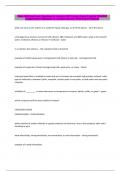Chem 104 Final Exam | Questions & Answers (100 %Score) Latest Updated 2024/2025
Comprehensive Questions A+ Graded Answers | With Expert Solutions
what can serve as the solvent in a solution? liquid, solid, gas, or all of the above. - all of the above
a homogeneous mixture consists of 12% ethanol, 28% methanol, and 60% water. what is the solvent?
water, methanol, ethanol, or ethanol + methanol - water
in a solution, the solute is: - the substance that is dissolved
example of colloid: grape juice, homogenized milk, blood, or kool-aid. - homogenized milk
example of suspension: blood, homogenized milk, apple juice, or mayo. - blood
unknown liquid that is insoluble in water but not in benzene (an aromatic hydrocarbon solvent). what
type of molecule is unknown? polar, nonpolar, neither polar or non polar, or both polar and non polar -
nonpolar
solubility of _________ in water decreases as temperature increases. liquids, solids, or gases? - gases
which compound will be most soluble in hexane?
CH3CH2OH CH3OH
CH3CH2CH2OH - CH3CH2CH2OH
water solution of sodium chloride is a good conductor of electricity. due to this property, table salt is
classified as a(n):
weak electrolyte, strong electrolyte, non-electrolyte, or semi-electrolyte - strong electrolyte
example of a weak electrolyte
,MgCl2, HC2H3O2, HNO3, or KOH - HC2H3O2
in order to prevent the process off either crenation or hemolysis with red blood cells an intravenous
solution concentration should be__________ to the concentration of blood.
hypotonic, hypertonic, isotonic, or all of the above. - isotonic
the process of crenation occurs when the concentration outside a cell is ______ and is said to be
_________.
lower in concentration; hypotonic
higher in concentration; hypertonic
higher in concentration; hypotonic
higher in concentration; hypertonic
none of these - higher in concentration; hypertonic
air can be classified to be a solution of several gases. which gas is considered to be the solvent?
O2, N2, CO2, or H2O - N2
arrange the terms solution, suspension, and colloid in order of increasing size of the dispersed particles
(smallest to largest).
solution < suspension < colloid
solution < colloid < suspension
suspension < solution < colloid
colloid < solution < suspension - solution < colloid < suspension
identify the type of transport that will occur for the sodium ions that requires energy for transport
,passive diffusion
active transport
facilitated diffusion
all of the above
none of the above - active transport
identify the type of transport that will occur for the oxygen molecules that requires no energy for
transport
passive diffusion
active transport
facilitated diffusion
all of the above
none of the above - none of the above
predict which will fully dissociate (strong electrolyte) in water
sugar
organic acid pyruvic
KCl
all
none - KCl
in order to prevent the process of either crenation or hemolysis with red blood cells an intravenous
solution concentration should be _______ to the concentration of blood.
hypotonic
hypertonic
, supersonic
isotopic
isotonic - isotonic
the glucose transporter provides facilitated transport across the cell membrane. do you think this
transporter is active after you eat a meal and after you wake up in the morning?
active, active
inactive, inactive
active, inactive
inactive, active - active, inactive
example of a nonelectrolyte
MgCl2
CH3COOH / HC2H3O2
sugar C12H22O11
NaOH - sugar C12H22O11
calculate mass percent of a solution prepared by dissolving 34.4g NaCl in 298 g of water.
a 10.35%
b 11.51 %
c 0.103 %
d 0.115 %
e none of the above - a 10.35%
what is 75% of 375? - 281.3




